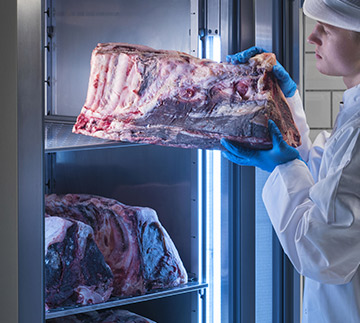
Interior Capacity
The capacity (depth) of the interior and shelving is suitable for all meat joints, including larger cuts such as striploins.
Williams Refrigeration Meat Ageing Refrigerator
Williams has market-leading expertise in meat ageing equipment. For over a decade the company has been working with butchers, Michelin star chefs and casual dining operators who specialise in offering their customers dry aged beef.
Led by their requirements and ideas, backed by our own expertise, the Williams engineering team has developed a range of specialist equipment to store meat while it ages to get best yield, texture and flavour.
With the launch of our stylish meat ageing refrigerator, Williams now offers a choice of meat ageing products, from compact cabinets to large volume coldrooms, to suit the needs of any business, however big or small.

The capacity (depth) of the interior and shelving is suitable for all meat joints, including larger cuts such as striploins.

Pink Himalayan salt blocks assist with moisture management, improve flavour and enhance the looks and theatre of the meat ageing refrigerator.
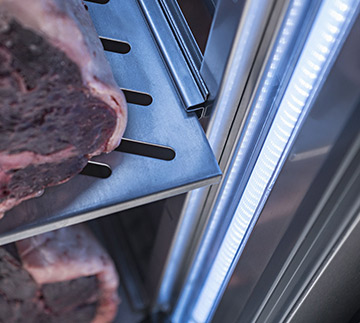
Internal bright, low heat, LED lighting delivers great energy savings and clear visibility of produce, helping create an eye-catching display.
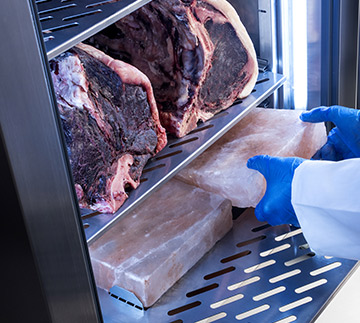
Supplied with four large, perforated stainless steel shelves with anti-tilt tray slides to prevent shelves from tipping.

Full length, heavy duty, stainless steel handle allows easy access, even one handed.

The activated Carbon Filter is designed to remove any organic molecules which cause odour from air circulated within the cabinet.
CoolSmart controller optimises refrigeration efficiency by minimising energy consumption whilst ensuring food safety. It also delivers easy operation, featuring clear digital display and visual alarm for failsafe performance.
Precision injected, high density polyurethane insulation provides maximum thermal properties with low GWP and zero ODP, and ensures a strong, rigid construction.
Cabinet maintains ideal climate for meat ageing – holding temperature at+1 to +6°C and humidity between 60-90%
Designed and engineered to operate in busy, unforgiving environments and in ambient temperatures of up to 43°C.
Natural hydrocarbon refrigerant with low GWP / zero ODP delivers superior thermal efficiency.
Versatile shelf racking system is made of stainless steel and can be adjusted to suit different loads. It is easily removable for cleaning.
Heavy duty, non-marking swivel castors with roller bearings and brakes improve both mobility and stability and make it easy to move the refrigerator for cleaning.
Heavy duty, PVC magnetic balloon gasket provides 100% tight seal, preventing heat ingress and enhancing energy efficiency.
Foodsafe professional stainless steel interior and exterior provides hygienic, durable and easy to clean surfaces.
Radiused interior base corners eliminate dirt traps, making cleaning easy.
Self-closing glass door ensures temperature retention and reduces energy consumption.
Humidity display detects and displays the level of humidity in the cabinet.
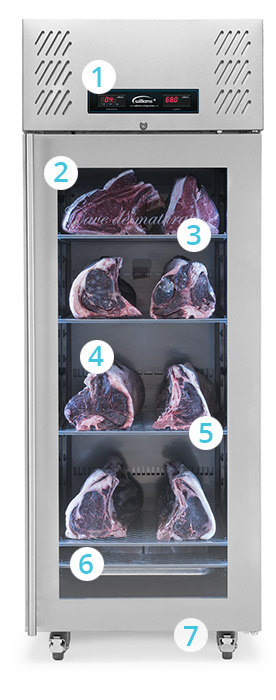
Key to the process of ageing meat is the environment in which the meat is stored.
Williams’ Meat Ageing Refrigerator operates at the ideal temperature range of +1 to +6°C and humidity between 60-90%, ensuring that meat ages perfectly. The inclusion of Himalayan salt blocks assists with moisture management and improves the flavour of the meat.
Stylish design is combined with a robust stainless steel construction. The meat ageing refrigerator is able to operate in ambient temperatures of up to 43°C and the interior is brightly lit with energy saving LEDs, making it perfect for front of house display.
Meanwhile, a personalised touch can be added with Williams Chameleon wrap service, seamlessly adapting the refrigerator to any décor or setting.
The perfect ageing conditions are maintained by the presence of a self-closing glass door, coupled with heavy duty PVC magnetic balloon gaskets that provide a 100% tight seal.
A barrel lock also provides security and reassurance for front of house operation. The Williams CoolSmart controller ensures energy efficiency and a clear digital display shows the status of the unit at all times.
The process of ageing meat is one that has been around for centuries, but its emergence into more mainstream dining culture is a result of the foodservice industry becoming aware of how the process improves the flavour of meat, tenderises it and enhances the whole dining experience.
Alongside the importance of the quality of meat on the plate is the ‘food theatre’ that a meat ageing display can create front of house – which is why Williams’ Meat Ageing Refrigerator features designer looks as well as market-leading refrigeration expertise.
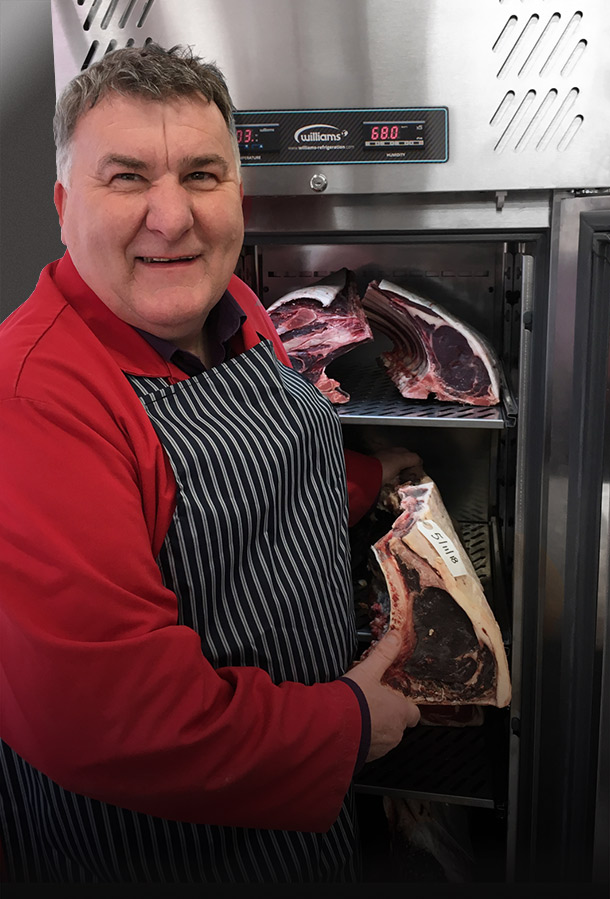
The Howell family business first opened a butcher’s shop in the beautiful North Norfolk coastal town of Wells-next-the-Sea in 1889. Not surprisingly, the family believes strongly in traditional methods, provided they deliver the quality their customers expect.
On the other hand, Arthur Howell and his family are not ones to rest on their laurels – over the past years they’ve opened up a bakery, deli, fish monger and, in the neighbouring village of Binham, a smokehouse.
“Customers like theatre, things that stand out and are different. The Williams Meat Ageing cabinet certainly delivers. It looks great and it looks after the meat really well.”
ARTHUR HOWELL
As a traditional butcher, Arthur has always been keen on meat ageing. So when Williams Refrigeration launched a meat ageing cabinet he was keen to try it out. “Dry meat ageing is a centuries-old method and the reason it’s back in fashion is all about quality,” he says. “The process delivers more flavour and tenderises the meat. Having said that, it’s also about theatre – if you want to stand out you need to be different and the more you display, the more you sell.”
The Williams Meat Ageing Cabinet is a very attractive display unit. The full length glass door and internal display lights ensure the meat is eye catching, while the solid, stainless steel construction looks great and is easy to keep clean and smart.
The Pink Himalayan Rock Salt Williams supplies with the cabinet adds a touch of the exotic, as well as helping the meat ageing process. Arthur says, “When we first installed it, it was the talk of the shop for weeks. It’s a real conversation starter. For example, customers will ask about the darkness of the meat, and they’ll say things like, “Dry aged meat – wow! That’s different.” There’s no doubt it’s had a positive impact on business.”
The cabinet comes with either a hanging rail or shelves. “We prefer shelves – we have four and the meat looks very good, and there’s plenty of space.”
Arthur Howell's TIPS ON MEAT AGEING
• 28 days is the minimum to make a real impact on taste and texture.
• Beef is the most popular meat to dry age, but lamb works well, too. I would only dry age lamb under 21 days
• If the meat is on show make sure there’s plenty of light in the cabinet
• Keep meat on the bone during ageing
• Avoid cuts like topside: you don’t want too much lean meat on the outside edge
So it looks good, but how about the results? “We’ll keep the meat for 4-6 weeks and all the joints are expensive cuts of meat – mainly sirloins and ribs. So we need to be confident that the cabinet will look after it! And it does: all the meat ages really well. As the meat loses moisture it shrinks a little – over four weeks in the Williams cabinet we’re losing less than 10%. Also, with dry aged meat there can be an issue with mould. We’ve had none of that with the Williams cabinet. I can’t fault it!”
Dry ageing the meat adds to its value – and the price customers are willing to pay.
“At the moment we’re adding £4 a kilo, so a sirloin that starts off as £26 a kilo will be £30 once it’s been aged. It’s early days but I reckon customers would be happy to pay more for the meat, because it has great flavour and tenderness.”
ARTHUR HOWELL
Staff like the Williams cabinet, too. “It’s easy on the eye and it’s easy to look after and clean,” says Arthur. He also likes the solid, robust construction, “The door is nice and heavy,” he says. The Howells have Williams products in other shops, including a Multideck in the deli and a freezer in the bakery. “Another plus with Williams is that it’s easy to get service and to get hold of spares,” says Arthur.
The Williams Meat Ageing Cabinet is a very attractive display unit. The full length glass door and internal display lights ensure the meat is eye catching, while the solid, stainless steel construction looks great and is easy to keep clean and smart.
The Williams Meat Ageing Cabinet is designed to hold meat in ideal conditions, so it operates at a temperature of +1 to +6°C and controls relative humidity at 60-90%. The refrigeration system’s CoolSmart controller ensures it always operates safely and as energy efficiently as possible, by only switching the system on when its required – so during quiet periods, such as overnight, power consumption is minimal. It’s also available in a wide range of colours and textures, thanks to Williams’ Chameleon vinyl wrap service, to match a site’s décor.
Williams has market-leading expertise in meat ageing equipment. For over a decade the company has been working with butchers, Michelin star chefs and casual dining operators who specialise in offering their customers dry aged beef.
Led by their requirements and ideas, backed by our own expertise, the Williams engineering team has developed a range of specialist equipment to store meat while it ages to get best yield, texture and flavour.
Now we can offer a choice of meat ageing products, from compact cabinets to large volume coldrooms, to suit the needs of any business, however big or small.
And the Williams name means you can rely on the equipment to deliver absolute temperature control and reliability.
Although dry ageing meat is a centuries-old practice, the fashion for dry aged beef has really picked up in the last few years. Why do it? Mainly because it gives a fabulous end product – a steak that’s tender, full of flavour and delivers a greatly enhanced dining experience.
However, the end product is only part of the trend – these days many restaurants will display the meat, front of house, as a statement. There’s a certain amount of theatre to it, of course, but also by showing the meat ageing the restaurant is underlining its credentials, by displaying the process and the quality of the meat. Plus, it’s a real point of difference and a great customer draw.
In terms of what sort of meat can you dry age, the answer is mutable. Beef is by far the most popular and the key criteria is that meat should be well marbled, so grain- or corn-fed animals are best.
Longhorn, Angus and Hereford are amongst popular breeds for meat ageing. The joints should be on the bone and ideally have a covering of fat, so cuts like sirloin and rib are ideal. As for alternatives to beef, some push pork as a good meat ageing prospect, others lamb – even poultry has its advocates.
Dry ageing steak gives a fabulous end product – a steak that’s tender, full of flavour and delivers a greatly enhanced dining experience
Before the science, a little history. Meat ageing has been around for centuries, ever since humans discovered meat tasted better and was more tender if it was left to hang for a while rather than being eaten fresh. Dry ageing the meat extends the ageing process – the down side being the time and expense involved.
Ageing means the enzymes in the beef break down its muscle tissue, making it more tender. Meanwhile the evaporation of moisture from the meat concentrates the beef flavour. Many argue the result is the best beef you’ll ever taste.
It’s essential that the meat is stored not only at the right temperature but also at the right relative humidity, typically 60-90%. Which is why a standard fridge or coldroom is not good for dry meat ageing – it will usually have a relative humidity of around 50%, which isn’t enough.
Previously meat was aged in coldrooms without humidity control, with the result that mould would grow on it. The mould could be trimmed off, but obviously this impacted not only on the yield but also the look of the meat as it aged.
Fresh cut meat is bright red and marbled. As it ages it turns darker. After the animal has been slaughtered it may be hung for up to 10-12 days before the dry meat ageing process begins. So how long should beef be aged for?28 days is standard, though some chefs and butchers age their meat for significantly longer, since it intensifies the flavour. In 2014 the Dallas Chop House in Texas served a steak that had been dry-aged for 459 days! The loss of moisture will reduce size and yield: the longer the ageing, the lower the yield. Sticking to good quality beef should maximise yield – without doubt, British is best.
It’s essential that the meat is stored not only at the right temperature but also at the right relative humidity
Williams supplies its dry meat ageing cabinets with Himalayan rock salt, because it assists the ageing process. The beautiful pink salt (the colour is the result of trace minerals such as calcium and potassium) comes from the Great Salt Range in the Himalayas.
When it comes to meat ageing, some say Himalayan rock salt benefits include inhibiting bacteria growth
The salt deposits were formed hundreds of millions of years ago and discovered, according to legend, by Alexander the Great. For centuries the salt has been promoted for its health benefits, being used in all sorts of ways, from spa caves to salt lamps. When it comes to meat ageing, some say its benefits include inhibiting bacteria growth, helping the enzymes break down the muscle tissues and enhancing the flavour.
The three core elements are;
• Good beef • A good butcher • A good meat ageing cabinet or cold room that you can rely on to get on with the job.
One critical aspect of dry ageing meat is stock rotation – so it’s absolutely vital that meat is clearly labelled and dated.
Stock rotation is critical - so it’s vital that meat is clearly labelled